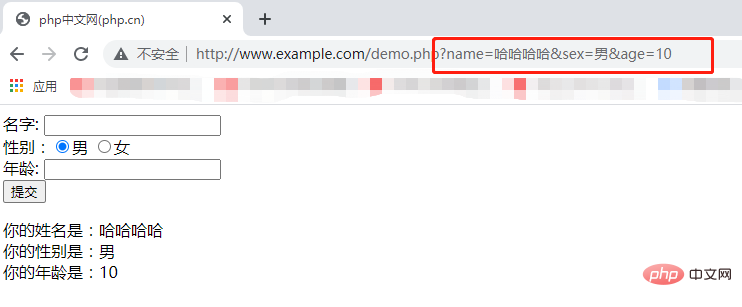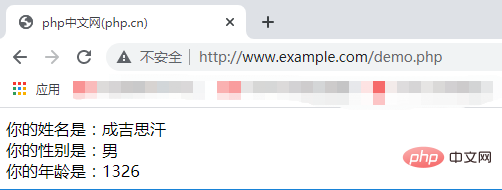 Backend Development
Backend Development
 PHP Tutorial
PHP Tutorial
 PHP form learning: The use and difference of $_GET and $_POST variables
PHP form learning: The use and difference of $_GET and $_POST variables
PHP form learning: The use and difference of $_GET and $_POST variables
In the previous article, I brought you "PHP form learning: How to verify the email and URL in the form?" ", which introduces in detail the knowledge about how to verify emails and URLs in forms in PHP. In this article, we take a look at the $_GET variables and $_POST variables in PHP. I hope everyone has to help!

In the previous article we have learned how to validate the required data and how to validate the email and URL in the form through regular expressions. Among them are the shadows of $_GET variables and $_POST variables. Next, let’s take a look at $_GET variables and $_POST Knowledge related to the use of variables.
<span style="font-size: 20px;">PHP $_GET </span>Variables
We have learned about it before when we were studying# The ##$_GET variable is used to collect values from the form with method="get". Information sent from a form with the GET method is visible to everyone (displayed in the browser's address bar), and there are limits on the amount of information sent. In fact, it can also be viewed as an array of variables passed to the current script through URL parameters.
<html>
<head>
<meta charset="utf-8">
<title>php中文网(php.cn)</title>
</head>
<body>
<form action="demo.php" method="get">
名字: <input type="text" name="name"><br>
性别:<input type="radio" name="sex" value="男" checked>男
<input type="radio" name="sex" value="女">女<br>
年龄: <input type="text" name="age"><br>
<input type="submit" value="提交">
</form>
</body>
</html><?php
header("Content-type:text/html;charset=utf-8"); //设置编码
echo "你的姓名是:" .$_GET['name'] ."<br/>";
echo "你的性别是:" .$_GET['sex']."<br/>";
echo "你的年龄是:".$_GET['age'];
?>

method="get" in an HTML form, all variable names and values will be displayed in the URL. So you should not use this method when sending passwords or other sensitive information! However, because the variables appear in the URL, you can bookmark the page. In some cases this is useful.
<strong>$_POST<span style="max-width:90%"></span></strong> Variables
$_GET variable, let’s take a look at the $_POST variable. The predefined $_POST variable is used to collect data from method= The value in the form of "post".
$_GET variable, and is not visible to anyone. There is also no limit to the amount of information. However, by default, the maximum amount of information sent by the POST method is 8 MB, which can be changed by setting post_max_size in the php.ini file.
<html>
<head>
<meta charset="utf-8">
<title>php中文网(php.cn)</title>
</head>
<body>
<form action="demo.php" method="post">
名字: <input type="text" name="name"><br>
性别:<input type="radio" name="sex" value="男" checked>男
<input type="radio" name="sex" value="女">女<br>
年龄: <input type="text" name="age"><br>
<input type="submit" value="提交">
</form>
</body>
</html><?php
header("Content-type:text/html;charset=utf-8"); //设置编码
echo "你的姓名是:" .$_POST['name'] ."<br/>";
echo "你的性别是:" .$_POST['sex']."<br/>";
echo "你的年龄是:".$_POST['age'];
?>
##$_GET<strong><span style="font-size: 20px;"></span></strong> and $_POST
is to obtain data from the server, and post is to transmit data to the server. get adds the parameter data queue to the URL pointed to by the ACTION attribute of the submitted form. The value corresponds to each field in the form and can be seen in the URL. Post uses the HTTP post mechanism to place each field in the form and its content in the HTML HEADER and transmit it to the URL address pointed to by the ACTION attribute. Users cannot see this process.
For the get method, the server side uses Request.QueryString to obtain the value of the variable. For the post method, the server side uses Request.Form to obtain the submitted data.
The amount of data transferred by get is small and cannot be larger than 2KB. The amount of data transmitted by post is relatively large and is generally unrestricted by default. But in theory, the maximum amount is 80KB in IIS4 and 100KB in IIS5.
Get security is very low, post security is high. But the execution efficiency is better than the Post method.
The differences between the two are organized into a table. The table is as follows:
| $_POST | ||
|---|---|---|
| There will be a limit on the number of characters that will be displayed in the URL | ||
| Generally a small amount of data less than 2k | PHP can submit a large amount of 8M data by default | |
| Unsafe | More secure | |
| The submitted data is isolated | Submit the data as a whole | |
| Very flexible, you can transfer data with a page jump | Not flexible, you must have the participation of a form | |
| More commonly used | Less compared with $_GET |
- The get method is less secure than the Post method. If confidential information is included, it is recommended to use the Post data submission method;
- is working When querying data, it is recommended to use the Get method; when adding, modifying or deleting data, it is recommended to use the Post method;
- If you are interested, you can click "
》Learn more about PHP knowledge.
The above is the detailed content of PHP form learning: The use and difference of $_GET and $_POST variables. For more information, please follow other related articles on the PHP Chinese website!

Hot AI Tools

Undresser.AI Undress
AI-powered app for creating realistic nude photos

AI Clothes Remover
Online AI tool for removing clothes from photos.

Undress AI Tool
Undress images for free

Clothoff.io
AI clothes remover

Video Face Swap
Swap faces in any video effortlessly with our completely free AI face swap tool!

Hot Article

Hot Tools

Notepad++7.3.1
Easy-to-use and free code editor

SublimeText3 Chinese version
Chinese version, very easy to use

Zend Studio 13.0.1
Powerful PHP integrated development environment

Dreamweaver CS6
Visual web development tools

SublimeText3 Mac version
God-level code editing software (SublimeText3)

Hot Topics
 1671
1671
 14
14
 1428
1428
 52
52
 1329
1329
 25
25
 1276
1276
 29
29
 1256
1256
 24
24
 PHP vs. Python: Understanding the Differences
Apr 11, 2025 am 12:15 AM
PHP vs. Python: Understanding the Differences
Apr 11, 2025 am 12:15 AM
PHP and Python each have their own advantages, and the choice should be based on project requirements. 1.PHP is suitable for web development, with simple syntax and high execution efficiency. 2. Python is suitable for data science and machine learning, with concise syntax and rich libraries.
 PHP: A Key Language for Web Development
Apr 13, 2025 am 12:08 AM
PHP: A Key Language for Web Development
Apr 13, 2025 am 12:08 AM
PHP is a scripting language widely used on the server side, especially suitable for web development. 1.PHP can embed HTML, process HTTP requests and responses, and supports a variety of databases. 2.PHP is used to generate dynamic web content, process form data, access databases, etc., with strong community support and open source resources. 3. PHP is an interpreted language, and the execution process includes lexical analysis, grammatical analysis, compilation and execution. 4.PHP can be combined with MySQL for advanced applications such as user registration systems. 5. When debugging PHP, you can use functions such as error_reporting() and var_dump(). 6. Optimize PHP code to use caching mechanisms, optimize database queries and use built-in functions. 7
 PHP and Python: Comparing Two Popular Programming Languages
Apr 14, 2025 am 12:13 AM
PHP and Python: Comparing Two Popular Programming Languages
Apr 14, 2025 am 12:13 AM
PHP and Python each have their own advantages, and choose according to project requirements. 1.PHP is suitable for web development, especially for rapid development and maintenance of websites. 2. Python is suitable for data science, machine learning and artificial intelligence, with concise syntax and suitable for beginners.
 PHP in Action: Real-World Examples and Applications
Apr 14, 2025 am 12:19 AM
PHP in Action: Real-World Examples and Applications
Apr 14, 2025 am 12:19 AM
PHP is widely used in e-commerce, content management systems and API development. 1) E-commerce: used for shopping cart function and payment processing. 2) Content management system: used for dynamic content generation and user management. 3) API development: used for RESTful API development and API security. Through performance optimization and best practices, the efficiency and maintainability of PHP applications are improved.
 The Enduring Relevance of PHP: Is It Still Alive?
Apr 14, 2025 am 12:12 AM
The Enduring Relevance of PHP: Is It Still Alive?
Apr 14, 2025 am 12:12 AM
PHP is still dynamic and still occupies an important position in the field of modern programming. 1) PHP's simplicity and powerful community support make it widely used in web development; 2) Its flexibility and stability make it outstanding in handling web forms, database operations and file processing; 3) PHP is constantly evolving and optimizing, suitable for beginners and experienced developers.
 PHP and Python: Different Paradigms Explained
Apr 18, 2025 am 12:26 AM
PHP and Python: Different Paradigms Explained
Apr 18, 2025 am 12:26 AM
PHP is mainly procedural programming, but also supports object-oriented programming (OOP); Python supports a variety of paradigms, including OOP, functional and procedural programming. PHP is suitable for web development, and Python is suitable for a variety of applications such as data analysis and machine learning.
 PHP vs. Other Languages: A Comparison
Apr 13, 2025 am 12:19 AM
PHP vs. Other Languages: A Comparison
Apr 13, 2025 am 12:19 AM
PHP is suitable for web development, especially in rapid development and processing dynamic content, but is not good at data science and enterprise-level applications. Compared with Python, PHP has more advantages in web development, but is not as good as Python in the field of data science; compared with Java, PHP performs worse in enterprise-level applications, but is more flexible in web development; compared with JavaScript, PHP is more concise in back-end development, but is not as good as JavaScript in front-end development.
 PHP and Python: Code Examples and Comparison
Apr 15, 2025 am 12:07 AM
PHP and Python: Code Examples and Comparison
Apr 15, 2025 am 12:07 AM
PHP and Python have their own advantages and disadvantages, and the choice depends on project needs and personal preferences. 1.PHP is suitable for rapid development and maintenance of large-scale web applications. 2. Python dominates the field of data science and machine learning.



